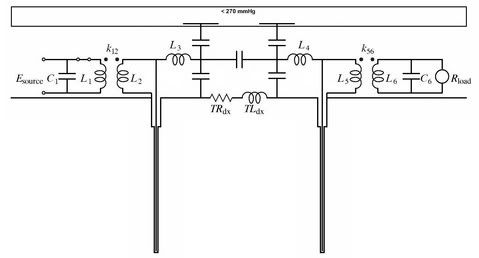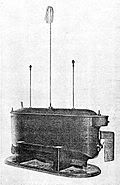Real0ne
Posts: 21189
Joined: 10/25/2004
Status: offline

|
quote:
ORIGINAL: mnottertail
The fuck you did. No, teslas (non extant transmitter) has nothing to do with nothing, that is the method he theorized for transmission, not collection. The collectors need to be at the edge of the atmosphere envelope, as your little drivel in the great earth capacitor intimates here. You see, insofar as even tesla is concerned a capactor only works with a ground.
the fuck I didnt.
Most of what you deny is historical record!
tesla found a way around that and I posted it earlier and as usual you are either swimming in da nile or skipped right over it.
quote:
Letting Tesla go wasn't the brightest thing Edison had ever done, though - George Westinghouse promptly snapped up the patent rights to Tesla's alternating-current motors, dynamos, and transformers. The buy-out triggered a power struggle which eventually saw Edison's direct-current systems relegated to second place, and the DC motors installed in German and Irish trains only a few years before, rendered obsolete.
But not without a fight. Advocates of direct-current power - desperate to discredit their alternating-current competitor - claimed that AC current was hazardous to humans. In support of their argument, DC defenders took the novel approach of using a standard Westinghouse (AC) generator to discharge death sentences in New York State.
An interesting approach (to say the least), although futile in the long run.
In 1893 Westinghouse used Tesla's alternating-current system to light the World's Columbian Exposition in Chicago.
Edison was not a happy man. His company, General Electric, had also bid for the lighting contract, but the GE proposal would have cost roughly twice as much and have produced less light for a lot more heat.
In a snit, Edison tried to ban the use of 'his' light bulbs with Telsla's electrical system, and urged General Electric to bar the use of the company's lamps in any Westinghouse exhibits.
Despite Edison's tantrums, Westinghouse soon gained a contract to build the massive turbines at Niagara Falls, and alternating-current was firmly entrenched.
. . . . . . . . . . . . . . . . . . . .
Tesla went on to set up his own lab.
Within a short time, he had pre-empted Wilhelm Rontgen's discovery of X-rays with his own experimental shadowgraphs; the relays, vacuum tubes, and transistors of future decades with his electric logic circuits; even the wireless radio - the principles of which were described by Tesla in minute detail years before Marconi transmitted his first morse code message.
Tesla, on hearing of Marconi's efforts, is said to have remarked to a friend: "Marconi is a good fellow. Let him continue. He is using 17 of my patents." If so, Tesla changed his mind eventually, suing Marconi for patent breach.
The court eventually found for Tesla after examining some circuit diagrams he had designed in 1893, and Marconi's patents were declared invalid in 1935. Unfortunately, the law suit dragged out until a few months after Tesla's death and he never saw a penny in compensation.
. . . . . . . . . . . . . . . . . . . .
Always, Tesla returned to electricity - Tesla loved electricity, and was fascinated with lighting, speaking often of some future world filled with electric light.
In a determined effort to prove the safety of his new alternating-current lighting system, Tesla would often light lamps by using his own body as an electrical conductor, to the somewhat muted cheers of an uneasy audience.
Turning to studies of resonance, by 1898 Tesla had designed an oscillator that generated half a million volts.
Convinced he could develop enough power to: "split the earth like an apple" and disinclined - for reasons he no doubt thought good ones at the time - to destroy New York City, Tesla moved his experiments to Knob Hill near Colorado Springs, in a structure that included a roll-back roof to prevent fires from the sparks sent out while he tinkered with transformers.
The first time Tesla tested one of his inventions at full power, the roar was heard for more than 16 kilometres (10 miles).
Unfortunately, Nikola's test also blacked out the entire city of Colorado Springs and set the power generator on fire. Amicable relations were restored when Tesla paid to replace the generator.
He backfed the generators by accident
(The people of Colorado Springs must have been a tolerant lot. Tesla's experiments would sometimes result in sparks coming up through the ground of the city and sparking from fire hydrants - one experiment grounded out the plumbing of the entire city.)
Tesla's Magnifying Transmitter, an early type of Tesla Coil that measured 16 metres (52 feet) in diameter, could transmit tens of thousands of watts without wires.
ts simply a given, historical record, you deny it
Tesla managed to light 200 lamps, without wires, from 40 kilometres (25 miles) away. But his proudest achievement was the production of man-made lightning. The Magnifying Transmitter could produce incredible electrical flashes measuring up to 41 metres (135 feet).
That is an error, the TMT produces no sparks or flashes on purpose since it reduces the efficiency
Unfortunately, when Tesla left the lab in 1900, the structure was demolished and the contents sold to pay debts. Very little survived of some of Tesla's most amazing inventions.
. . . . . . . . . . . . . . . . . . . .
In January 1900, capitalised by financier J P Morgan, Tesla returned to New York to work on his ‘wireless world broadcasting tower’. Even before Marconi's morse code 's' hit the airwaves, Tesla was determined that his invention wasn't going to be limited to dots and dashes.
Tesla planned on linking the world together through its telephone and telegraph systems, transmitting pictures and text from one end of the globe to the other in minutes, and delivering mail between special terminals, using electronic messaging.
Labour disputes and financial panic got in the way, and Tesla's Long Island construction was abandoned when Morgan withdrew funding. It was Tesla's greatest disappointment, and a loss to the entire world.
Once again, much of Tesla's work was lost when the Wardenclyffe Tower was dismantled for scrap towards the end of World War One.
. . . . . . . . . . . . . . . . . . . .
During the Panic of 1907, Tesla ensured the survival of the Westinghouse company by giving up patent payments for a nominal sum. By doing so, he also ensured his own financial ruin.
When World War One began in 1914, Tesla lost his payments from European patents. By 1916, he was living in poverty and had filed for bankruptcy to escape a massive tax debt.
Soon afterwards, Tesla began to show symptoms of Obsessive-Compulsive Disorder. The symptoms became pronounced very quickly, and what was left of his already 'eccentric' reputation was soon in tatters.
Still, he wouldn't give up. Tesla turned down an attempt by European friends to raise funds and continued to exist on a modest pension from Yugoslavia. He moved into a small hotel room and continued to research.
< Message edited by Real0ne -- 5/22/2012 11:28:23 AM >
_____________________________
"We the Borg" of the us imperialists....resistance is futile
Democracy; The 'People' voted on 'which' amendment?
Yesterdays tinfoil is today's reality!
"No man's life, liberty, or property is safe while the legislature is in session
|



 Profile
Profile





 "!
"! 


 New Messages
New Messages No New Messages
No New Messages Hot Topic w/ New Messages
Hot Topic w/ New Messages Hot Topic w/o New Messages
Hot Topic w/o New Messages Locked w/ New Messages
Locked w/ New Messages Locked w/o New Messages
Locked w/o New Messages Post New Thread
Post New Thread